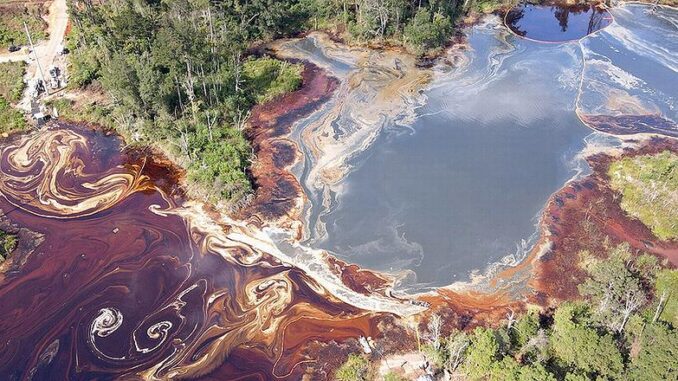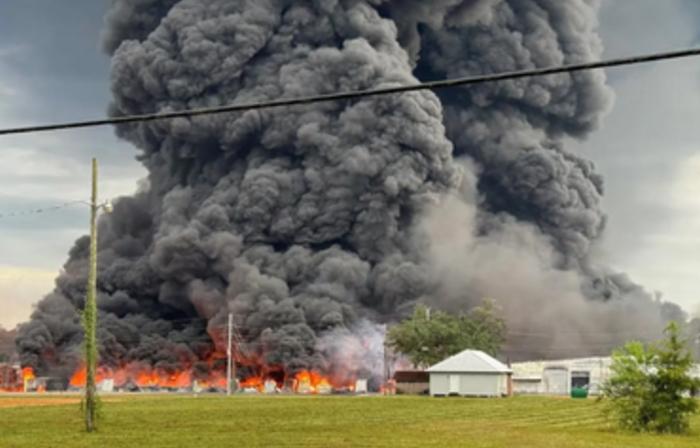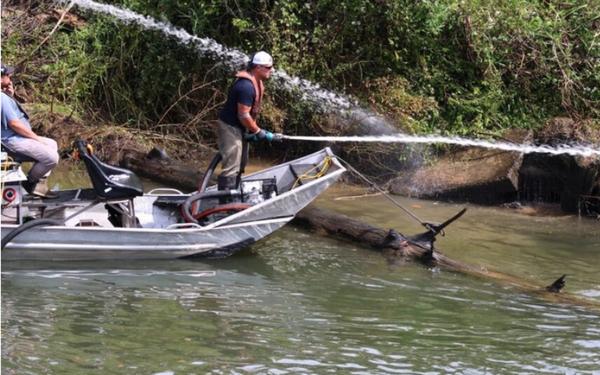
By Wesley Muller
ROSELAND, Louisiana, October 9, 2025 (ENS) – On August 22, an explosion erupted at Smitty’s Supply, a lubricant manufacturing facility in Roseland, a town about 60 miles northeast of Baton Rouge. The blaze swept through the 15-acre complex that housed half a million gallons of flammable materials.
Large amounts of petrochemicals still blanket nearby bodies of water six weeks after the explosion in Tangipahoa Parish, where some affected residents believe the federal and state governments have failed in their response and aren’t telling the truth about the health and environmental risks.
Candy Cardwell, who lives a few hundred yards from the Smitty’s Supply Inc. plant, walked around her property on a Tuesday in early October and pointed to black oily residue embedded into virtually everything from the roof of her home to the ground.
On the side of her roof facing the Smitty’s plant, shingles are stained with black oily residue, discolored compared to the other side’s reddish brown shingles. Cardwell’s gutters, surface concrete, fence, patio furniture, grass and vegetation all bear the same dark stains. She said she had to dig up her fruit and vegetable garden and dispose of the entire harvest because the plants were covered in oil and soot.
She has tried scrubbing and cleaning her furniture and concrete, but she said the stains won’t come out. Cardwell’s dog, Rusty, became ill soon after the incident and still hasn’t recovered, she said.
“It fell literally on everything,” Cardwell said. “This was my little piece of heaven … Now, it’s a sad state.”

Residents across Tangipahoa Parish have reported similar property damage after the fire at Smitty’s Supply. The explosion sent smoke, soot and oily residue into the air and onto nearby homes, businesses and an elementary school. Petroleum products from the plant also spilled into area waterways, including several adjacent ponds and the Tangipahoa River. By the weekend after the explosion, oil had reached waterways 30 miles south of Roseland.
Now, oily materials have traveled nearly 40 miles down the waterway that leads to Lake Pontchartrain.
About three miles away in Amite, the home of Mike and Kathleen Bassemier bears many of the same markings. Black residue is stuck to everything, from leaves in the trees to recently painted concrete around their pool.
Even pressure washing the concrete didn’t get rid of the residue, they said. Like Cardwell, the Bassemiers also have a dog that’s been sick for weeks.
“You could walk out in the backyard barefoot, and your feet would be black,” Mike Bassemier said.
The couple’s biggest concern is their home’s roof, which they said was just replaced in 2021. Just like at Cardwell’s house, the shingles are covered with oily residue, and all three wonder if the chemicals could deteriorate the roofing materials or make them flammable.
Even those without property have had their lives impacted.
Stephen Williams, a Bogalusa native who said he’s lived along the Tangipahoa River in Amite for the past few months, said he had to get rid of his tent after it was soaked with soot and oily residue. He and his dog, Tick Tock, now live under the Louisiana Highway 16 bridge, though Williams said they had to move temporarily when cleanup crews returned Tuesday.
Williams said he and Tick Tock have struggled to find enough to eat since the Smitty’s Supply explosion. Before, the river was their primary food source.
“Being homeless when something like this oil happens can be tough,” the 61-year-old said as rainbow sheens of petrochemicals floated down the river behind him. “Sometimes fishing’s the only way we eat at night.”
Cardwell and the Bassemiers said they want straight answers about what hazards the chemical residue poses. Immediately after the incident and again this week, the U.S. Environmental Protection Agency has insisted the soot poses no imminent health risk. However, soot in general is known to contain a number of carcinogens and heavy metals, according to the National Institutes of Health.
EPA Blamed for Withholding Information on Chemicals
Within days of the explosion, the EPA received an inventory list of the chemicals at the Smitty’s plant at the time of the incident, but the agency withheld the information from the public for five weeks.
The EPA finally disclosed it to the Louisiana Illuminator last week only after the agency got permission from Smitty’s Supply executives to release it. The Louisiana Illuminator is part of States Newsroom, the nation’s largest state-focused nonprofit news organization.
Detailed on a 305-page spreadsheet, the inventory list included a variety of flammable and otherwise hazardous products.
Rough estimates indicate Smitty’s Supply stored several million gallons of motor oils, lubricants and various automotive fluids. Hydraulic fluids, gas mixtures, methanol, drilling oils, solvents, acids, bases and other petrochemical products were also part of its inventory on hand.
Lawsuit Calls for Greater Transparency
LaCrisha McAllister, an environmental justice attorney representing a Roseland farmer who is suing Smitty’s Supply, said she’s not surprised to hear of other sick animals because her client’s cow gave birth to a stillborn calf and believes it was due to the chemical exposure. She said officials should be more forthright about what chemicals were on site at the Smitty’s plant at the time of the fire and which specific ones were actually burned or exploded.
“That speaks to a bigger, more dangerous issue … What really is this?” McAllister said in a phone interview. “We don’t know what this will look like down the line.”
She recommended that affected residents prioritize their health and well-being, take any sick pets to a veterinarian and document any damages or changes that have occurred since the fire in case they need it for insurance or legal purposes.
After nearly six weeks of being surrounded by chemical contaminants and polluted ponds and rivers, Cardwell and the other residents said they hope things return to normal soon – to the way they were before the explosion.
It’s a promise they say they’ve heard Governor Jeff Landry repeat in the weeks since the explosion.
The governor addressed recovery efforts again Wednesday at a news conference in Tangipahoa Parish, simultaneously praising the Trump administration’s response and acknowledging that it could’ve been better.
“No plan is 100 percent perfect,” Landry told reporters at the parish government offices in Amite. “There’s been no hiding of the ball. We’ve been completely transparent.”
The governor’s comments came just days after drone video revealed the extent of the pollution still present near the Smitty’s facility. The footage, which went viral on social media Sunday, prompted Landry to issue a video message from the Governor’s Mansion, saying the EPA was working too slowly in its recovery efforts.
After connecting with several state officials and EPA regional coordinator Scott Mason, the governor promised in his video that cleanup efforts would intensify soon.
“You know it’s been over a month now that the Smitty’s facility caught fire…and over those 30 days, contractors contracted by the EPA were supposed to be cleaning that up,” Landry said Sunday. “And they’re not going fast enough.”
The governor walked back some of those comments Wednesday, saying he doesn’t believe any of the government agencies have failed and that he has full confidence in Mason, an appointee from President Donald Trump’s first term.

At a news conference, Mason said the drone footage shows only what’s on the surface of the water and isn’t a good indicator of how much oily material has already been removed. He estimated his agency has completed about 75 percent of the restoration of the Tangipahoa River.
“We know that we can always increase our pace and our progress to clean up a spill of this magnitude and also protect human health across this community,” Mason said.
Cardwell said she has lost trust in the government’s integrity and wonders why it has taken so long to get this rapid mobilization of government resources.
“I was really irritated at the governor who said he would be with us every step of the way and make Roseland whole again,” Cardwell said. “I’m tired of hearing what you’re gonna do … We worked hard for what we have, and I have more years behind me than I have ahead of me. It’s heartbreaking.”
Featured image: Petrochemicals still filled ponds near the Tangipahoa River across the street from the destroyed Smitty’s Supply facility in Roseland, nearly six weeks after it exploded. September 30, 2025, (Photo by Wes Muller/Louisiana Illuminator)
Editor’s Note: This article was first published by the Louisiana Illuminator. Used with permission. The Louisiana Illuminator is part of States Newsroom, the nation’s largest state-focused nonprofit news organization.

